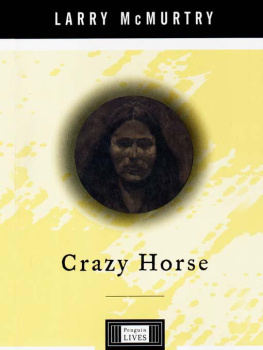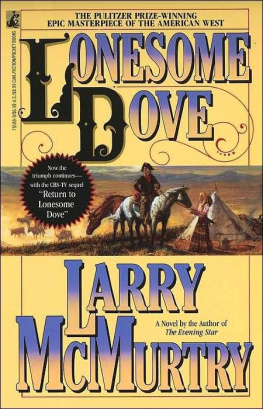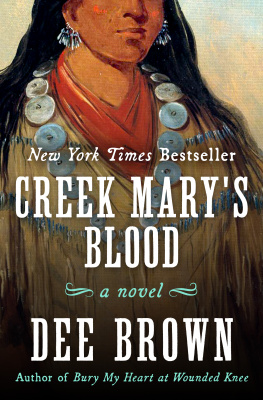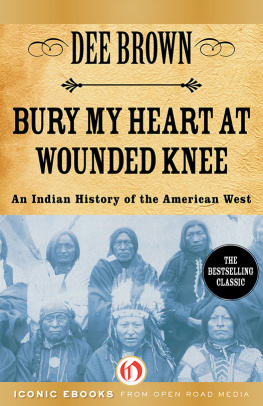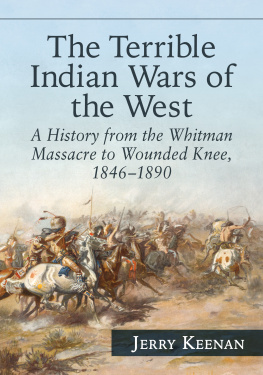
BY LARRY MCMURTRY
The Colonel and Little Missie
Loop Group
Folly and Glory
By Sorrows River
The Wandering Hill
Sin Killer
Sacagaweas Nickname: Essays on the American West
Paradise
Boones Lick
Roads
Still Wild: A Collection of Western Stories
Walter Benjamin at the Dairy Queen
Duanes Depressed
Crazy Horse
Comanche Moon
Dead Mans Walk
The Late Child
Streets of Laredo
The Evening Star
Buffalo Girls
Some Can Whistle
Anything for Billy
Film Flam: Essays on Hollywood
Texasville
Lonesome Dove
The Desert Rose
Cadillac Jack
Somebodys Darling
Terms of Endearment
All My Friends Are Going to Be Strangers
Moving On
The Last Picture Show
In a Narrow Grave: Essays on Texas
Leaving Cheyenne
Horseman, Pass By
BY LARRY MCMURTRY AND DIANA OSSANA
Pretty Boy Floyd
Zeke and Ned
LARRY
McMURTRY

OH WHAT A
SLAUGHTER
Massacres in the American West 1846-1890


SIMON & SCHUSTER
Rockefeller Center
1230 Avenue of the Americas
New York, NY 10020
www.SimonandSchuster.com
Copyright 2005 by Larry McMurtry
All rights reserved,
including the right of reproduction
in whole or in part in any form.
SIMON & SCHUSTER and colophon are registered trademarks of Simon & Schuster, Inc
For information about special discounts for bulk purchases,
please contact Simon & Schuster Special Sales at
1-800-456-6798 or business@simonandschuster.com
Designed by Karolina Harris
Photography consultant: Kevin Kwan
Manufactured in the United States of America
10 9 8 7 6 5 4 3 2 1
Library of Congress Cataloging-in-Publication Data
McMurtry, Larry.
Oh what a slaughter: massacres in the American West, 18461890 / Larry McMurtry.
p. cm.
Includes bibliographical references and index.
1. Indians of North AmericaWarsWest (U.S.) 2. Indians of North AmericaWest (U.S.)History19th century. 3. MassacresWest (U.S.)History19th century. I. Title.
E78.W5M35 2005
978'.02dc22 2005051849
ISBN-13: 978-0-7432-5077-1
eISBN-13: 978-1-4391-4149-6
ISBN:10: 0-7432-5077-X
Photo credits will be found on page 177.
Comes the most heartrending tale of all. As I have said Before General Custer with five companies went below the village to cut them off as he supposed but instead he was surrounded and all of them killed to a man 14 officers and 250 men There the bravest general of modder times met his death with his two brothers, brotherinlaw and nephew not 5 yards apart, surrounded by 42 men of E Company. Oh what a slaughter how many homes made desolate by the sad disaster everyone of them were scalped and otherwise mutilated but the General he lay with a smile on his face.
PRIVATE THOMAS COLEMAN
I Buried Custer
OH WHAT A
SLAUGHTER
The Meat Shop

Of massacre (the noun) the OED suggests shambles, butchery, general slaughter, carnage, a definition that would probably work for the great scout Kit Carson, who called the 1846 massacre of an undetermined number of California Indians, in which he took part, a perfect butchery.
Of massacre (the verb) the same authority offers to violently kill, mutilate, mangle, a fair description of what was done to the victims in the course of the various massacres I intend to consider in this book.
The Encyclopaedia Britannica, eleventh edition, allots the subject a hasty paragraph, concluding thatthough the word is very obscurethe etymology suggests something like a meat shop: a very bloody place, a shambles, with discarded and undesirable pieces of meat scattered around.
The image of a meat shop seems apt to me, since what massacres usually do is reduce human beings to the condition of meat, though the bits of meat will be less tidily arranged than the cuts would normally be in a decent butcher shop.
If we know anything about man, its that hes not pacific. The temptation to butcher anyone considered undesirable seems to be a common temptation, not always resisted. The twentieth century, just passed, more or less began with the million-plus massacre of the Armenians by the Turks, and ended with the terrible low-tech chopping up of some 800,000 Tutsis in Rwanda, an old-style massacre mostly accomplished with hoes and hatchets. When it ended a good deal of Rwanda resembled a meat shop.
What I want to do in this book is look at several massacres that occurred in the American West during the several decades when the native tribes of our plains and deserts were being displaced from their traditional territories by a vast influx of white immigrants. This process began in the 1830s, but accelerated sharply in the 1840s and 1850s: it was mostly completed, insofar as the native tribes were concerned, by 1890.
Judged by world-historical perspectives these massacres were tiny. The Custer defeat in 1876, a military encounter that, to the great surprise of the general who was soon to lie dead with a smile on his face, was the only one of these encounters to involve more than two hundred dead, a figure hardly to be counted among the worlds huge cruelties. Though I describe here and there some tiny massacres, involving only a handful of people, I am mainly concerned with the famous massacres, with death tolls over one hundred people.
But it should be remembered that the body count in the six massacres Im especially interested in still adds up to fewer than one thousand people, barely one-third of the number who died in New York and Washington on September 11, 2001.
But places and contexts differ: in the thinly populated West of the nineteenth century the violent extinction of more than one hundred people was no light thing, though a few of the assailants at first pretended that it was. Massacres are not like vast natural disasters: the Galveston Flood, the San Francisco Earthquake, the eruption of Krakatoa.
Massacres require human volition, and the extremes that result not infrequently produce trauma and, sometimes, guilt. Though in most cases the men who did the killings I describe escaped legal retribution, they did not escape the trauma that followed on the terror they inflicted.
Nephi Johnson, one of the participants in the Mountain Meadows Massacre, died crying Blood, blood, blood!

Nephi Johnson
Though more than a century has passed since Wounded Knee, the most recent of these massacres, bitterness has yet to leach out of the descendants of those massacred. Very probably one of the reasons The Church of Jesus Christ of Latter-day Saints (the Mormons) continues to deny complicity in the Mountain Meadows Massacrealthough an abundance of evidence makes clear that they led itis because there are in Arkansas and elsewhere descendants of the 121 people killed on that September day in 1857. Many of those descendants might not be averse to suing this now very prosperous church.
Next page

